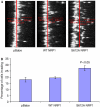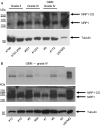Chondroitin sulphate-modified neuropilin 1 is expressed in human tumour cells and modulates 3D invasion in the U87MG human glioblastoma cell line through a p130Cas-mediated pathway
- PMID: 18704117
- PMCID: PMC2572126
- DOI: 10.1038/embor.2008.151
Chondroitin sulphate-modified neuropilin 1 is expressed in human tumour cells and modulates 3D invasion in the U87MG human glioblastoma cell line through a p130Cas-mediated pathway
Abstract
Neuropilin 1 (NRP1), a non-tyrosine kinase receptor for vascular endothelial growth factor and class 3 Semaphorins, is highly expressed in many human tumour cell lines, but its function is poorly understood. Here, we describe the expression of a new chondroitin sulphate-modified NRP1 (NRP1-CS) in human tumour cell lines. Expression of a non-modifiable NRP1 mutant (S612A) in U87MG human glioma cells results in enhanced invasion in three dimensions (3D), whereas wild-type NRP1 has no effect. Furthermore, the S612A NRP1 cells show a significant increase in p130Cas tyrosine phosphorylation compared with control and wild-type NRP1 cells. Silencing of p130Cas in S612A NRP1 cells resulted in a loss of increased invasive phenotype. Interestingly, p130Cas silencing does not inhibit basal 3D invasion, but leads to a mesenchymal to amoeboid transition. Biopsies from both low- and high-grade human gliomas show strong expression of NRP1, and little expression of NRP1-CS. Our data establish distinct roles for NRP1 and NRP1-CS in modulating a new NRP1-p130Cas signalling pathway contributing to glioblastoma cell invasion in 3D.
Conflict of interest statement
This study was financially assisted in part by Ark Therapeutics Plc, which is developing therapies targeted at inhibition of neuropilin. I.C.Z. is a consultant to Ark Therapeutics Plc. P.F., L.C. and P.L. are employees of Ark Therapeutics Plc. M.L.T. was a past employee of Ark Therapeutics Plc.
Figures






References
-
- Bachelder RE, Wendt MA, Mercurio AM (2002) Vascular endothelial growth factor promotes breast carcinoma invasion in an autocrine manner by regulating the chemokine receptor CXCR4. Cancer Res 62: 7203–7206 - PubMed
-
- Bielenberg DR, Pettaway CA, Takashima S, Klagsbrun M (2006) Neuropilins in neoplasms: expression, regulation, and function. Exp Cell Res 312: 584–593 - PubMed
-
- Cheng L, Jia H, Lohr M, Bagherzadeh A, Holmes DI, Selwood D, Zachary I (2004) Anti-chemorepulsive effects of vascular endothelial growth factor and placental growth factor-2 in dorsal root ganglion neurons are mediated via neuropilin-1 and cyclooxygenase-derived prostanoid production. J Biol Chem 279: 30654–30661 - PubMed
Publication types
MeSH terms
Substances
Grants and funding
LinkOut - more resources
Full Text Sources
Other Literature Sources
Molecular Biology Databases
Miscellaneous

